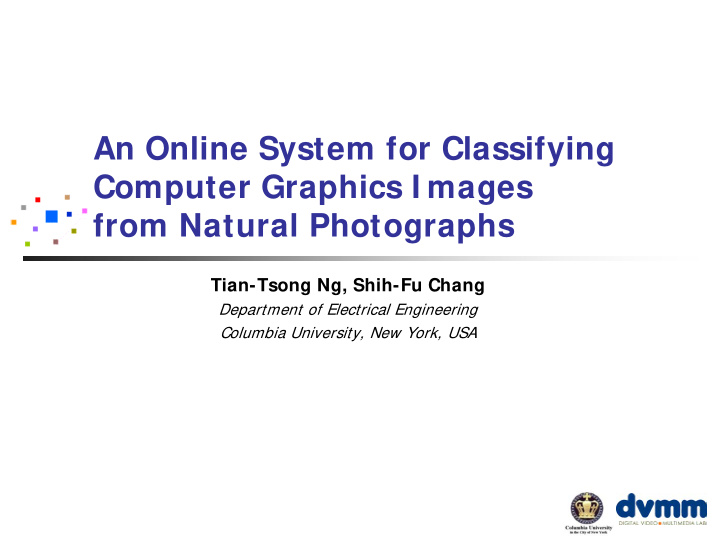



An Online System for Classifying Computer Graphics I mages from Natural Photographs Tian-Tsong Ng, Shih-Fu Chang Department of Electrical Engineering Columbia University, New York, USA
Background Passive-blind Image Forensics Finding out the condition of an image without any prior � information. Two main functions: � CG Or Photo? Image Forgery Detection � � [Ng et al. 04] Photomontage Detection. Image Source Identification � � Photo vs. CG I mage Forgery Hall of Fame http://www.fakeorfoto.com By Alias (CG company) LA Times ‘03 Internet ‘04 Nat. Geo. Times ‘96 ‘92
Prior Work Photo vs. CG [Ianeva et al. 03] Classifying photo and general CG (including � drawing and cartoon). For the purpose of improving video key-frame retrieval. � [Lyu & Farid 05] Classifying photo and photorealistic CG. � � Using wavelet statistics. � 67% detection rate (1% false alarm). � provides little insight into the physical differences between photo and CG. [Ng et al. 05] Analyzing the differences in the image generative � process for Photo and CG. Capture the differences with features derived from fractal � geometry, differential geometry and local patch statistics. The geometry classifier outperforms the methods in prior work. �
Objectives for the Online System � Further evaluate our technique in an open and realistic environment – the Internet. � To compare the various proposed techniques for classifying Photo and CG. � The geometry, wavelet and cartoon classifiers. � As an educational tool for promoting the awareness on the credibility of the online images.
The Online CG-Photo Classification System Online Demo I User Interface Select Enter image classifiers URL (any images from the web) Enter image Information for survey URL: http://www.ee.columbia.edu/trustfoto/demo-photovscg.htm
Image Types for Survey Online Interface
The Results Page Image Information Detection Results Classifier Combined by SVM fusion (described later)
match Key mismatch Sample Results Consistency with Human Judgments Human Judgments CG Photo Statistics for online system Note: Users sometimes provide wrong image types.
System Design Challenges � The diverse input images from the Internet. � Not only just photorealistic CG, but also non-photorealistic CG, photo-CG-hybrid, painting or drawing and so on. � Solution: We include a class of non-photorealistic CG in our training data. � Reasonable per-image processing speed. � Should not be more than a few minutes. � Solution: We reduce the processed image size. � Classification accuracy. � Reduction of image size results in the loss of image details, hence, lower the classification accuracy. � Solution: We adopt classifier fusion which takes the training dataset diversity into account.
Dataset Columbia Open Dataset � First publicly available Photo/CG dataset. � Consists of 4 subsets, 800 images for each subset. From a few Recaptured Personal Google Internet personal CG Photo Photo CG collections of photo Recaptured from Downloaded from Downloaded from the a LCD screen by Google Image Search 3D artist websites a Canon G3 camera Available at http://www.ee.columbia.edu/trustfoto
Challenge I: Diverse Input Images Non-photorealistic CG for Training � For the online classifiers to handle CG other photorealistic CG, we includes a category of 800 non- photorealistic CG for classifier training. Recaptured Personal Google Internet CG Photo Photo CG Non- photorealistic Mainly for CG recapturing attack Downloaded from evaluation Google Image Search
Challenge II: Processing speed Image Size Reduction To improve the processing speed, we reduce the size of the � input images to 360 pixels on the longer side. The speed improves by at least 2 times, as the typical size of � Internet images is about 700x500 pixels. We experiment with 2 strategies: � Downsizing – resolution reduction. � Central cropping – keeping central portion of the image without � resolution change. Conclusion � Both strategies lead to a performance degradation. � Downsizing has a more uniform degradation over the 3 classifiers. � Sharp degradation: Global information matters.
Challenge III: Classification Accuracy Classification Fusion To improve the classification accuracy, we produce a family of � base classifiers by exploiting the heterogeneity of the training dataset for classifier fusion. Diverse Non- Personal Google Internet content type photorealistic Photo Photo CG & from a few CG professional cameras. Photorealistic Diverse type of post- Non-photorealistic processing and camera.
Classification Fusion Generate 9 sets of two-class data by exhaustively combining the � elements of the power set of the Photo and CG classes. Results for the fusion (geo+ wav+ car) classifier: � A gain of 2% in classification accuracy for the downsized images. � Close to the performance of the original image size classifier. � For geometry + wavelet + cartoon classifier
Conclusions � We deploy an online Photo vs. CG online classification system. � http:/ / www.ee.columbia.edu/ trustfoto/ demo- photovscg.htm � We have described the strategies for addressing the implementation challenges: � Diverse input images – adding a class of 800 non- photorealistic images. � Processing speed – reducing the image size for processing. � Classification accuracy – exploiting the heterogeneity of the dataset and classifier fusion.
Recommend
More recommend